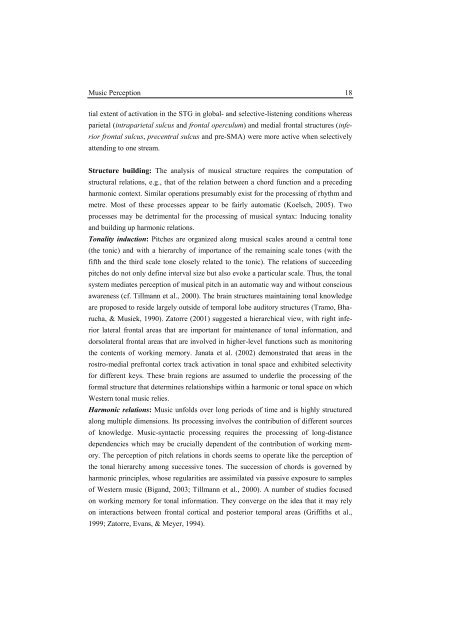Neural Correlates of Processing Syntax in Music and ... - PubMan
Neural Correlates of Processing Syntax in Music and ... - PubMan
Neural Correlates of Processing Syntax in Music and ... - PubMan
Create successful ePaper yourself
Turn your PDF publications into a flip-book with our unique Google optimized e-Paper software.
<strong>Music</strong> Perception 18<br />
tial extent <strong>of</strong> activation <strong>in</strong> the STG <strong>in</strong> global- <strong>and</strong> selective-listen<strong>in</strong>g conditions whereas<br />
parietal (<strong>in</strong>traparietal sulcus <strong>and</strong> frontal operculum) <strong>and</strong> medial frontal structures (<strong>in</strong>fe-<br />
rior frontal sulcus, precentral sulcus <strong>and</strong> pre-SMA) were more active when selectively<br />
attend<strong>in</strong>g to one stream.<br />
Structure build<strong>in</strong>g: The analysis <strong>of</strong> musical structure requires the computation <strong>of</strong><br />
structural relations, e.g., that <strong>of</strong> the relation between a chord function <strong>and</strong> a preced<strong>in</strong>g<br />
harmonic context. Similar operations presumably exist for the process<strong>in</strong>g <strong>of</strong> rhythm <strong>and</strong><br />
metre. Most <strong>of</strong> these processes appear to be fairly automatic (Koelsch, 2005). Two<br />
processes may be detrimental for the process<strong>in</strong>g <strong>of</strong> musical syntax: Induc<strong>in</strong>g tonality<br />
<strong>and</strong> build<strong>in</strong>g up harmonic relations.<br />
Tonality <strong>in</strong>duction: Pitches are organized along musical scales around a central tone<br />
(the tonic) <strong>and</strong> with a hierarchy <strong>of</strong> importance <strong>of</strong> the rema<strong>in</strong><strong>in</strong>g scale tones (with the<br />
fifth <strong>and</strong> the third scale tone closely related to the tonic). The relations <strong>of</strong> succeed<strong>in</strong>g<br />
pitches do not only def<strong>in</strong>e <strong>in</strong>terval size but also evoke a particular scale. Thus, the tonal<br />
system mediates perception <strong>of</strong> musical pitch <strong>in</strong> an automatic way <strong>and</strong> without conscious<br />
awareness (cf. Tillmann et al., 2000). The bra<strong>in</strong> structures ma<strong>in</strong>ta<strong>in</strong><strong>in</strong>g tonal knowledge<br />
are proposed to reside largely outside <strong>of</strong> temporal lobe auditory structures (Tramo, Bharucha,<br />
& Musiek, 1990). Zatorre (2001) suggested a hierarchical view, with right <strong>in</strong>ferior<br />
lateral frontal areas that are important for ma<strong>in</strong>tenance <strong>of</strong> tonal <strong>in</strong>formation, <strong>and</strong><br />
dorsolateral frontal areas that are <strong>in</strong>volved <strong>in</strong> higher-level functions such as monitor<strong>in</strong>g<br />
the contents <strong>of</strong> work<strong>in</strong>g memory. Janata et al. (2002) demonstrated that areas <strong>in</strong> the<br />
rostro-medial prefrontal cortex track activation <strong>in</strong> tonal space <strong>and</strong> exhibited selectivity<br />
for different keys. These bra<strong>in</strong> regions are assumed to underlie the process<strong>in</strong>g <strong>of</strong> the<br />
formal structure that determ<strong>in</strong>es relationships with<strong>in</strong> a harmonic or tonal space on which<br />
Western tonal music relies.<br />
Harmonic relations: <strong>Music</strong> unfolds over long periods <strong>of</strong> time <strong>and</strong> is highly structured<br />
along multiple dimensions. Its process<strong>in</strong>g <strong>in</strong>volves the contribution <strong>of</strong> different sources<br />
<strong>of</strong> knowledge. <strong>Music</strong>-syntactic process<strong>in</strong>g requires the process<strong>in</strong>g <strong>of</strong> long-distance<br />
dependencies which may be crucially dependent <strong>of</strong> the contribution <strong>of</strong> work<strong>in</strong>g memory.<br />
The perception <strong>of</strong> pitch relations <strong>in</strong> chords seems to operate like the perception <strong>of</strong><br />
the tonal hierarchy among successive tones. The succession <strong>of</strong> chords is governed by<br />
harmonic pr<strong>in</strong>ciples, whose regularities are assimilated via passive exposure to samples<br />
<strong>of</strong> Western music (Big<strong>and</strong>, 2003; Tillmann et al., 2000). A number <strong>of</strong> studies focused<br />
on work<strong>in</strong>g memory for tonal <strong>in</strong>formation. They converge on the idea that it may rely<br />
on <strong>in</strong>teractions between frontal cortical <strong>and</strong> posterior temporal areas (Griffiths et al.,<br />
1999; Zatorre, Evans, & Meyer, 1994).












